Recently Published
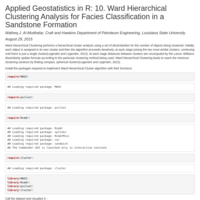
Applied Geostatistics in R: 10. Ward Hierarchical Clustering Analysis for Facies Classification in a Sandstone Formation
Ward Hierarchical Clustering performs a hierarchical cluster analysis using a set of dissimilarities for the number of objects being clustered. Initially, each object is assigned to its own cluster and then the algorithm proceeds iteratively, at each stage joining the two most similar clusters, continuing until there is just a single cluster(Legendre and Legendre, 2012). At each stage distances between clusters are recomputed by the Lance–Williams dissimilarity update formula according to the particular clustering method being used. Ward Hierarchical Clustering leads to reach the minimum clustering variance by finding compact, spherical clusters(Legendre and Legendre, 2012).
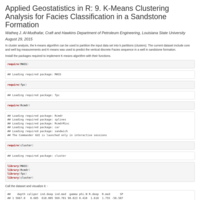
Applied Geostatistics in R: 9. K-Means Clustering Analysis for Facies Classification in a Sandstone Formation
In cluster analysis, the k-means algorithm can be used to partition the input data set into k partitions (clusters). The current dataset include core and well log measurements and K-means was used to predict the vertical discrete Facies sequence in a well in sandstone formation.
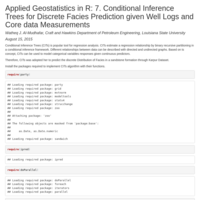
Applied Geostatistics in R: 7. Conditional Inference Trees for Discrete Facies Prediction given Well Logs and Core data Measurements
Conditional Inference Trees (CITs) is popular tool for regression analysis. CITs estimate a regression relationship by binary recursive partitioning in a conditional inference framework. Different relationships between data can be described with directed and undirected graphs. Based on ts concept, CITs can be used to model categorical variables responses given continuous fpredictors.
Therefore, CITs was adopted her to predict the discrete Distribution of Facies in a sandstone formation through Karpur Dataset.
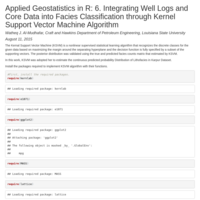
Applied Geostatistics in R: 6. Integrating Well Logs and Core Data into Facies Classification through Kernel Support Vector Machine Algorithm
The Kernal Support Vector Machine (KSVM) is a nonlinear supervised statistical learning algorithm that recognizes the discrete classes for the given data based on maximizing the margin around the separating hyperplane and the decision function is fully specified by a subset of the supporting vectors. The posterior distribution was validated using the true and predicted facies counts matrix that estimated by KSVM.
In this work, KSVM was adopted her to estimate the continuous predicted probability Distribution of Lithofacies in Karpur Dataset.
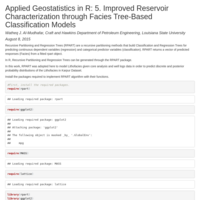
Applied Geostatistics in R: 5. Improved Reservoir Characterization through Facies Tree-Based Classification Models
Recursive Partitioning and Regression Trees (RPART) are a recursive partitioning methods that build Classification and Regression Trees for predicting continuous dependent variables (regression) and categorical predictor variables (classification). RPART returns a vector of predicted responses (Facies) from a fitted rpart object.
In R, Recursive Partitioning and Regression Trees can be generated through the RPART package.
In this work, RPART was adopted here to model Lithofacies given core analysis and well logs data in order to predict discrete and posterior probability distributions of the Lithofacies in Karpur Dataset.

Applied Geostatistics in R: 4. Multinomial Logistic Regression (MLR) for Posterior Lithofacies Probability Prediction in a Sandstone Formation
The Multinomial Logistic Regression (MLR) was adopted to estimate the maximum likelihood and minimize the standard error for the nonlinear relationships between facies & core and log data in sandstone formation. The MLR is used to predict the probabilities of the different possible facies given each independent variable by constructing a linear predictor function having a set of weights that are linearly combined with the independent variables by using a dot product. Beta distribution of facies was considered as prior knowledge and the resulted predicted probability (posterior) was estimated from MLR based on Bayes’ theorem that represents the relationship between predicted probability (posterior) with the conditional probability and the prior knowledge.
In this work, MLR was adopted here to model Lithofacies given core analysis and well logs data in order to predict posterior probability distributions of the Lithofacies in Karpur Dataset.
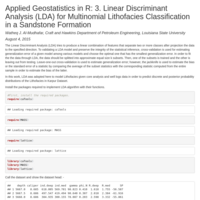
Applied Geostatistics in R: 3. Linear Discriminant Analysis (LDA) for Multinomial Lithofacies Classification in a Sandstone Formation
The Linear Discriminant Analysis (LDA) tries to produce a linear combination of features that separate two or more classes after projection the data to the specified direction. To validating a LDA model and preserve the integrity of the statistical inference, cross-validation is used for estimating generalization error of a given model among various models and choose the optimal one that has the smallest generalization error. In order to fit the the data through LDA, the data should be splitted into approximate equal size k subsets. Then, one of the subsets is trained and the other is leaving out from testing. Leave-one-out cross-validation is used to estimate generalization error; however, the jackknife is used to estimate the bias or the standard error of a statistic by comparing the average of the subset statistics with the corresponding statistic computed from the entire sample in order to estimate the bias of the latter.
In this work, LDA was adopted here to model Lithofacies given core analysis and well logs data in order to predict discrete and posterior probability distributions of the Lithofacies in Karpur Dataset.
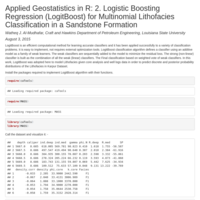
Applied Geostatistics in R: 2. Logistic Boosting Regression (LogitBoost) for Multinmial Lithofacies Classification in a Sandstone Formation
LogitBoost is an efficient computational method for learning accurate classifiers and it has been applied successfully to a variety of classification problems. It is easy to implement, not requires external optimization tools. LogitBoost classification algorithm defines a classifier using an additive model as a family of weak learners. The weak classifiers are sequnetially added to the model to minimize the residual loss. The strong (non-linear) classifier is built as the combination of all the weak (linear) classifiers. The Final classification based on weighted vote of weak classifiers.
In this work, LogitBoost was adopted here to model Lithofacies given core analysis and well logs data in order to predict discrete and posterior probability distributions of the Lithofacies in Karpur Dataset.

Applied Geostatistics in R: 1. Naive Bayes Classifier for Lithofacies Modeling in a Sandstone Formation
This article within a series of Applied Geostatistics in R.
Naive Bayes Classifier (NBC) is Bayesian algorithm that is used to compute the conditional posterior probabilities of a categorical class variable (Lithofacies) given independent predictor variables (core and well logs data) using the Bayes rule.